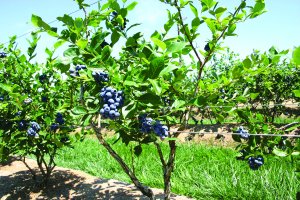 One of the shining stars in Oregon agriculture these days is the regal blueberry.
One of the shining stars in Oregon agriculture these days is the regal blueberry.
 Demand has spurred bigger blueberry crops in Oregon and prices are at all-time highs. Demand has spurred bigger blueberry crops in Oregon and prices are at all-time highs. |
SALEM — One of the shining stars in Oregon agriculture these days is the regal blueberry.
While crops such as strawberries, green beans and hops, once Willamette Valley mainstays, have slipped from prominence, blueberry popularity just keeps on climbing.
“The blueberry industry is one of the absolute success stories in Oregon agriculture,” says Bryan Ostlund, administrator of the Oregon Blueberry Commission in Salem.
The crop is also enjoying tremendous success nationwide, Ostlund says. “Blueberry nurseries can’t produce enough planting stock to keep up with grower demand and growers can’t keep up with buyer demand.”
In Oregon alone, blueberry acreage has grown from around 3,700 acres in 2003 to over 5,000 acres today — an increase of over 35% — and counting.
If it weren’t for poor pollination weather, winter freezes and stifling temperatures that stunted growth in many blueberry fields last summer, Oregon growers could easily have set an all-time harvest record of 40 million pounds, Ostlund says. “And the demand would have been there.”
As it turns out, the industry did set a record despite the poor conditions, with an estimated 35 million pounds. The previous Oregon record was 34 million pounds, which was set in 2004 and repeated in 2005.
Prices, too, are at all-time highs, with fresh market packers competing with processors, Ostlund said.
“Growers have never seen it this good,” says Steve Erickson, who handles grower support for Fall Creek Farm & Nursery near Springfield, North America’s largest blueberry nursery.
Celebrating its 30th birthday next year, Fall Creek, which occupies around 100 acres, grows over 40 varieties of blueberries for commercial growers and retailers. The young plants are sold either in containers or as bareroot stock and shipped all over the globe.
“We’ve got increasing crops in Oregon and the last few years we’ve had an increase in prices, and normally those two don’t go hand in hand,” says Erickson, who was a grower and processor in the Salem area before joining Fall Creek.
According to Erickson, blueberry acreage in Oregon has been increasing 300 to 500 acres a year for the last several years. “That’s more than double where it was just a few years ago.” What’s behind the boom? In a word: health.
Blueberries, which are touted as having super nutraceutical properties, are enjoying two distinct and robust markets, Ostlund says.
The first is well-to-do baby boomers facing health issues due to aging and years of bad diets. The second market is made up of parents and school district officials who are finally getting around to addressing juvenile obesity.
Blueberries have also entered the uncharted waters of the alcohol industry as a flavor agent. “Bacardi is in that market. So is Jack Daniel’s,” Ostlund says.
A report in 1996 by the U.S. Department of Agriculture on the health benefits of the fruit kicked off the Blueberry Boom. Since then, the U.S. Highbush Blueberry Council, which will spend a record $1.2 million in promotional activities in 2007, has been beating the nutraceutical drum.
The council also spends around $500,000 a year for research aimed at looking for even more healthful compounds in blueberries.
In Oregon, blueberries are marketed in one of two ways: fresh market and processed.
Processed berries usually end up in manufactured foods and beverages, such as pastries and fruit drinks.
Erickson, a 20-year veteran of the industry, says that increasing consumer demand for fresh blueberries has driven fresh market berries.
 “Historically, the U.S. industry has always sold more processed than fresh, but the last four years we’ve actually sold more fresh than processed. In Oregon we’re still a little heavier to processing,” he says.
“Historically, the U.S. industry has always sold more processed than fresh, but the last four years we’ve actually sold more fresh than processed. In Oregon we’re still a little heavier to processing,” he says.
Both a concern and a welcome trend for the U.S. blueberry industry is the increasing production in South American countries such as Chile and Argentina, which harvest their berries at opposite times of the year from the U.S., Ostlund says. “The foreign fresh market is actually a good thing because it extends the season and keeps people eating blueberries longer.”
On the other hand, offshore berries that are frozen and sold into the United States when the crop here is coming into production pose a direct threat in processing sectors.
The flip side to that is exports of Oregon blueberries to Pacific Rim countries and to Europe, which are helping bolster bullish blueberry markets in the U.S., Erickson says.
As for the future, “acres will continue to grow,” Ostlund says. “The issue for the industry is: When do you put the brakes on the whole thing?”
According to the Oregon field office of the USDA’s National Agricultural Statistical Service, Oregon ranks third in the country in blueberry production, with Michigan No. 1 and New Jersey at No. 2.
“It’s a great industry to be involved with right now,” says grower/packer Hugh Eisele, co-owner of Scenic Fruit in Gresham. “The near future looks real good for us.”
— John Schmitz
Have an opinion? E-mail [email protected]

